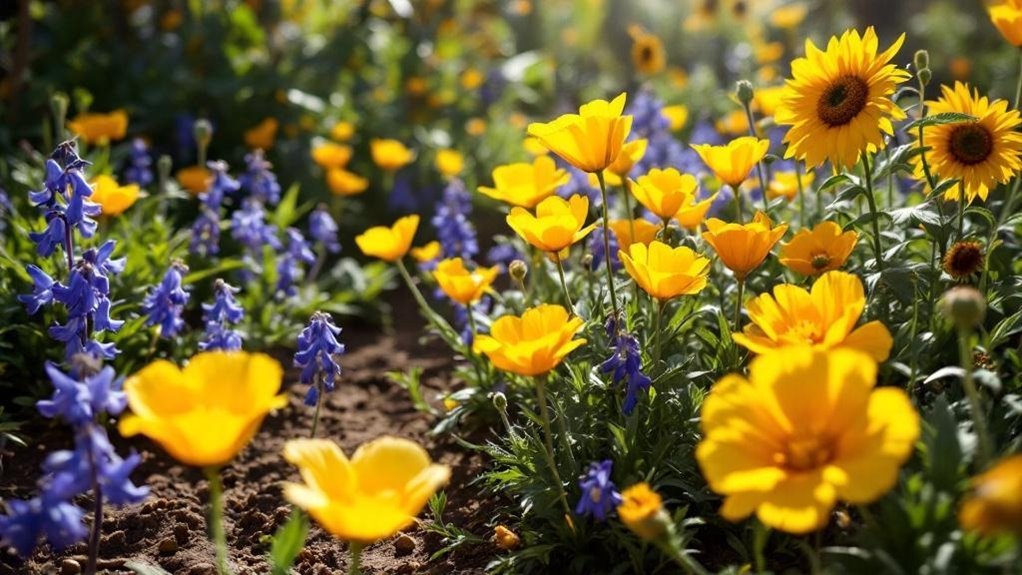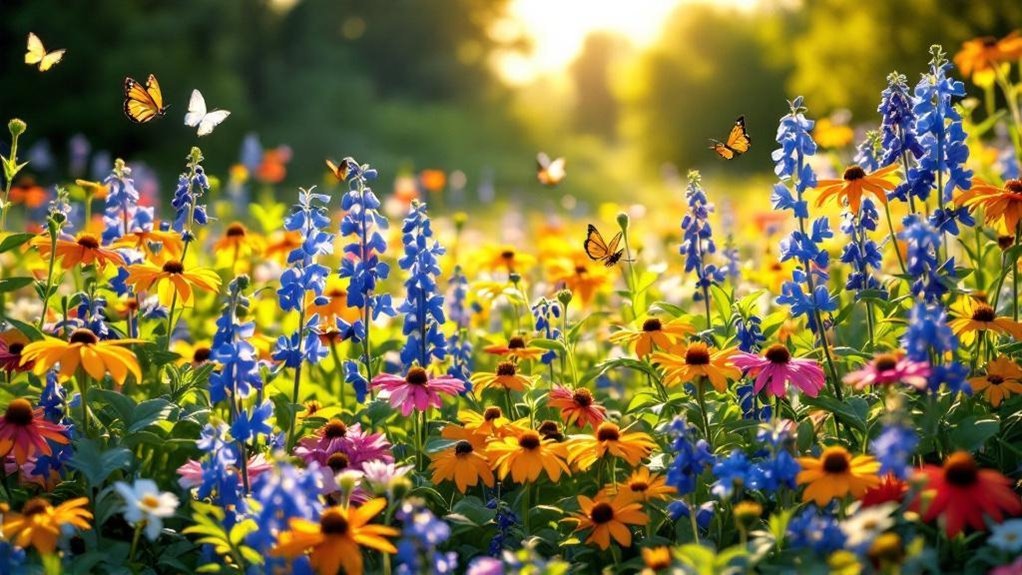When you choose native wildflowers for your garden, you’re not just adding color—you’re creating a habitat that supports local wildlife and thrives with less effort. These plants adapt naturally to your environment, offering beauty throughout the seasons while attracting crucial pollinators. But selecting the right species and understanding their specific needs can make all the difference in achieving a vibrant, sustainable garden that truly stands out.
Benefits of Planting Native Wildflowers
When you plant native wildflowers, you actively support local ecosystems by providing crucial food and habitat for pollinators like bees and butterflies.
These plants foster ecological balance since they thrive with minimal water and fertilizers, making them low maintenance. Their deep roots improve soil health by enhancing moisture retention and adding organic matter, which benefits your garden’s vitality.
Native wildflowers also boost biodiversity by attracting diverse wildlife, creating a resilient, thriving environment.
Beyond their environmental perks, many native wildflowers offer striking visual appeal, adding unique colors and textures throughout the seasons.
By choosing native wildflowers, you help sustain local ecosystems while enjoying a beautiful, sustainable garden that requires less effort and resources.
You’ll see firsthand how these plants enrich both your space and the surrounding natural world.
Top Native Wildflowers for Pollinators
Although many flowers attract pollinators, native wildflowers offer the best support for local bees, butterflies, and hummingbirds.
To create a vibrant garden, include bee balm and wild bergamot; both provide abundant nectar and pollen that attract pollinators like hummingbirds and butterflies.
Purple coneflower is another excellent choice, drawing bees and butterflies with its bright petals and later feeding birds with its seeds.
Oxeye sunflower blooms from spring to fall, offering a reliable nectar source.
Don’t forget milkweed, vital for monarch butterflies, as it’s the only food source for their caterpillars.
Finally, Cardinal Flower’s striking red blooms also lure hummingbirds.
Selecting Wildflowers for Different Sunlight Conditions

Native wildflowers not only support pollinators but also adapt to various sunlight conditions in your garden.
Native wildflowers thrive in diverse light conditions, providing essential support to pollinators in your garden.
When planting native, choosing wildflowers suited to full sun, partial shade, or full shade guarantees they thrive and maximize blooming potential.
For full sun, vibrant native species like Purple Coneflower and Black-Eyed Susan attract pollinators and flourish in bright light.
In partial shade, Wild Bergamot and Cardinal Flower provide nectar for hummingbirds while thriving with filtered sunlight.
If your garden has full shade, consider Jack-in-the-Pulpit or Dutchman’s Breeches, which prefer moist soil conditions and offer unique blooms.
Native plants are right for your garden because matching wildflowers to specific light and soil conditions enhances growth and supports local ecosystems effectively.
Soil Preparation for Thriving Wildflowers
Preparing your soil properly sets the foundation for wildflowers to thrive. Start with well-drained, organic-rich soil by mixing in compost, like mushroom or homemade variants. Since wildflowers favor low-nutrient environments, loosen just the top 1-2 inches to protect existing soil structure. Test soil pH to match native species’ preferences and adjust accordingly. Choose wildflowers suited to your garden’s light conditions and soil type to boost wildflower growth. After planting, monitor soil moisture closely to help roots establish.
| Factor | Recommendation |
|---|---|
| Soil Type | Well-drained, organic-rich soil |
| Soil Preparation | Lightly loosen top 1-2 inches |
| Nutrients | Avoid adding too many nutrients |
| Soil pH | Adjust to native species needs |
| Moisture | Maintain consistent soil moisture |
Seasonal Wildflower Highlights

Once your soil is ready and your wildflowers are planted, you’ll notice how different species shine throughout the year.
Different wildflower species bloom at various times, creating a vibrant, year-round garden display.
In early spring, native wildflowers like bloodroot and wild columbine signal warmer days and attract pollinators like bees.
As the growing season progresses, summer blooms such as black-eyed Susans and purple coneflowers create beautiful carpets of color, drawing butterflies and providing nectar for crucial pollinators.
When fall arrives, New England Aster and goldenrod take center stage, supporting late-season pollinators with their abundant nectar and seeds.
These seasonal highlights guarantee your garden remains vibrant and alive all year long, offering a dynamic display that benefits both you and local wildlife throughout every phase of the growing season.
Enhancing Wildlife Habitat With Native Plants
When you plant wildflowers like purple coneflower and milkweed, you create crucial habitats that support pollinators and other wildlife.
Native flowers and plants attract bees, butterflies, and birds, boosting biodiversity in your garden.
Perennials such as black-eyed Susan and wild bergamot not only add beauty but also improve soil health and moisture retention with their deep roots.
By choosing native species, you provide significant nectar and pollen sources that help sustain pollinator populations.
Milkweed and butterfly weed serve as breeding grounds for monarch butterflies, directly enhancing their survival.
This diverse native planting reduces the need for chemicals, making your garden a safer, thriving habitat for wildlife.
Embracing native wildflowers means you actively contribute to preserving local ecosystems and enriching your garden’s natural beauty.
Maintaining and Caring for Native Wildflowers
Although native wildflowers are generally low-maintenance, you’ll get the best results by matching them to your garden’s soil and light conditions.
Native wildflowers thrive in well-drained, organic-rich soils, so enrich your garden bed with mushroom or homemade compost to boost soil health. Choosing native perennials suited to your site helps minimize maintenance, as they require less water and fewer chemicals once established.
To keep your garden vibrant, monitor which wildflowers thrive and adjust your plant selections accordingly. Including a diverse range of native species supports a dynamic ecosystem, attracting various pollinators that enhance garden resilience.
Incorporating New Native Species Into Your Garden
Adding new native species to your garden enhances biodiversity and supports local pollinators like buckeye butterflies. When incorporating a diverse array of native species, such as twinflower, dwarf ironweed, and narrowleaf sunflower, you provide crucial habitat and food sources that attract pollinators and create a thriving ecosystem.
Pay close attention to each plant that grows, considering its soil and light requirements to guarantee successful establishment alongside existing plants. Monitoring the longevity and adaptability of new species helps you understand their long-term benefits and adjust your garden accordingly.
Additionally, incorporating native perennials like oxeye sunflower and purple coneflower can reduce the need for chemical maintenance, promoting ecological resilience. By thoughtfully adding native species, you enhance biodiversity and foster a sustainable, vibrant garden environment.
Frequently Asked Questions
What Is the Prettiest Wild Flower?
You might find the prettiest wildflower depends on your taste. Some love vibrant reds, others soft pinks or bright yellows. Choose the one that catches your eye and brightens your space the most.
Can I Just Throw Wildflower Seeds Around?
You might think scattering seeds like a magic spell will work, but you’ll get better results preparing soil, removing weeds, and mixing seeds with sand. Otherwise, your wildflowers won’t grow evenly or thrive as they should.
Do Native Plants Improve Air Quality?
Yes, native plants improve air quality by absorbing carbon dioxide, releasing oxygen, and filtering pollutants. You’ll also help soil health and support local wildlife, which keeps ecosystems balanced and air cleaner for everyone around you.
What Are the Best Wildflowers for Gardens?
Think of wildflowers as nature’s paintbrushes for your garden. You’ll love Purple Coneflower, Black-Eyed Susan, Wild Bergamot, Joe Pye Weed, and Oxeye Sunflower—they bring color, attract pollinators, and boost your garden’s life.
Final Thoughts
By choosing native wildflowers, you’re not just planting beauty—you’re creating a vibrant ecosystem buzzing with life. Imagine your garden alive with colorful blooms, butterflies dancing, and hummingbirds humming. But the real magic? It happens when you see how these hardy plants transform your space with minimal effort. Ready to watch nature’s wonders unfold right outside your door? Start planting native wildflowers today, and discover the secret that makes natural gardens truly unforgettable.